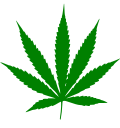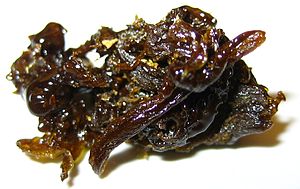Cannabis edible/ja: Difference between revisions
Tags: Mobile edit Mobile web edit |
Created page with "10歳未満の子どものカンナビス中毒は、ほぼ全てがエディブルによる偶発的摂取であり、その多くはお菓子のように見える製品を食べてしまうことが原因である。 この場合、通常は他の薬物は摂取されておらず、ティーンエイジャーよりも入院の可能性が高くなります。 2023年現在、多くの子どもが集中治療室で..." |
||
| (20 intermediate revisions by the same user not shown) | |||
| Line 48: | Line 48: | ||
すべての食品エディブルに共通する重要な基礎は、THCが注入された脂肪を含むことである。言い換えれば、バター、油、牛乳、またはその他の脂肪分を含む食品は、いずれもエディブルにすることができる。大麻入り食品の例には、焼き菓子、キャンディ、ポテトチップスなどがある。通常の焼き菓子とカンナビノイドを含む焼き菓子を区別できない場合がある。十分な量の大麻を使用した場合、軽い草のような、または大麻特有の風味を感じることがある。 | すべての食品エディブルに共通する重要な基礎は、THCが注入された脂肪を含むことである。言い換えれば、バター、油、牛乳、またはその他の脂肪分を含む食品は、いずれもエディブルにすることができる。大麻入り食品の例には、焼き菓子、キャンディ、ポテトチップスなどがある。通常の焼き菓子とカンナビノイドを含む焼き菓子を区別できない場合がある。十分な量の大麻を使用した場合、軽い草のような、または大麻特有の風味を感じることがある。 | ||
[[Dawamesc/ja|ダワメスク]] | [[Dawamesc/ja|ダワメスク]]は、アルジェリアや他の一部のアラブ諸国で見られる大麻食品であり、「砂糖、オレンジジュース、シナモン、クローブ、カルダモン、ナツメグ、ムスク、ピスタチオ、松の実」と大麻の穂先を組み合わせて作られる。 | ||
[[Happy pizza/ja|ハッピーピザ]]は、[[:en:Cambodia|カンボジア]]の[[pizza/ja|ピザ]]の一種であり、大麻入りの材料を含み、精神作用をもたらすのに十分な[[Tetrahydrocannabinol/ja|THC]]を含んでいる。 | [[Happy pizza/ja|ハッピーピザ]]は、[[:en:Cambodia|カンボジア]]の[[pizza/ja|ピザ]]の一種であり、大麻入りの材料を含み、精神作用をもたらすのに十分な[[Tetrahydrocannabinol/ja|THC]]を含んでいる。 | ||
大麻入りの[[Chocolate brownie/ja|ブラウニー]]には[[cocoa solids/ja|ココア固形分]]が含まれ、[[List of polysubstance combinations/ja|多重物質併用]]となる。 | |||
==== 飲料 ==== | |||
==== | {{see also/ja|Hemp beer/ja|hemp milk/ja}} | ||
{{see also|Hemp beer|hemp milk}} | [[File:Cannabis Energy Drink, Winschoten (2023) 04.jpg|thumb|upright|ヘンプを原料としたエナジードリンクの缶]] | ||
[[File:Cannabis Energy Drink, Winschoten (2023) 04.jpg|thumb|upright| | |||
{{multiple image | {{multiple image | ||
| width = 85 | | width = 85 | ||
| image1 = Bela pana.jpeg | | image1 = Bela pana.jpeg | ||
| image2 = Bhang (3948082027).jpg | | image2 = Bhang (3948082027).jpg | ||
| footer = [[Bhang]] | | footer = [[Bhang/ja|バングー]]飲料 | ||
}} | }} | ||
大麻入り飲料とは、THCを注入した飲料であり、大麻入り食品と同程度に強力である可能性がある。 | |||
米国の娯楽目的で大麻が合法化された州では、2014年に飲料は大麻市場の約4%を占めていたが、2016年には約1.5%に減少した。大麻入り飲料は、コーヒー、紅茶、ソーダ、[[alcohol (drug)/ja|アルコール]]の形態をとることができる。THC入りの[[Carbonated water/ja|セルツァー]]は急成長中の大麻飲料カテゴリであり、アルコールの代替としてますます人気を集めている。 | |||
一覧: | |||
* [[Bhang/ja|バングー]] | |||
* [[Bhang]] | * [[Cannabis tea/ja|大麻茶]] | ||
* [[Cannabis tea]] | * [[Maltos-Cannabis/ja|マルトス・カンナビス]] | ||
* [[Maltos-Cannabis]] | * [[Pabst Blue Ribbon THC-infused seltzer/ja|パブスト・ブルーリボンTHC入りセルツァー]] | ||
* [[Pabst Blue Ribbon THC-infused seltzer]] | |||
===== チンキ剤 ===== | |||
== | {{further/ja|Tincture of cannabis/ja}} | ||
{{further|Tincture of cannabis}} | |||
[[:en:European Medicines Agency|欧州医薬品庁(EMA)]]によれば、大麻チンキ剤(''tincturea'')は[[ethanol/ja|エタノール]]、[[water/ja|水]]、[[glycerol/ja|グリセロール]]、[[propylene glycol/ja|プロピレングリコール]]、[[fatty oils/ja|脂肪油]]を抽出溶媒として用いて得られる液状の大麻抽出物の一種である。チンキ剤の種類(および使用する溶媒)によって、特定の質量/体積比や特定の[[therapeutic agents/ja|治療成分]]含有量を有する場合がある。チンキ剤は強力なアルコールベースの大麻抽出物であり、[[THC/ja|THC]]はエタノールに1g/mL以上溶解する。チンキ剤は口腔および舌から吸収されることを目的としているため、エディブルに分類される。通常はスポイトを用いて舌の下に滴下し、血流に吸収させる。チンキ剤はあらゆる食品や飲料に加えることができ、大麻入り食品や飲料に比べて用量をより正確に管理できる。 | |||
==== 水溶性カンナビノイドパウダー ==== | |||
==== | 水溶性カンナビノイドパウダーは無味無臭であり、経口大麻製品特有の効果をもたらす可能性がある。このパウダーは水に溶けやすく、食品や飲料に混ぜることができる。従来のエディブルは効果発現に約90分かかる場合があるが、カンナビノイドパウダーはその溶解性と消化管での吸収により、特にTHCの場合、20分以内に効果が現れることがある。 | ||
==== CBDエディブル ==== | |||
=== | [[Cannabidiol/ja|カンナビジオール]](CBD)エディブルは精神作用および酩酊作用を持たず、メーカーによって異なる量のTHCを含む。これらのエディブルは、THCによる精神作用反応を伴わずに大麻の効果を提供する。 | ||
[[Cannabidiol]] | |||
==== カプセル ==== | |||
= | 大麻の[[Capsule (pharmacy)/ja|カプセル]]は[[Gastrointestinal tract/ja|消化管]]で代謝されるため、エディブルに分類される。カプセルにはTHCまたはCBDのいずれかを含めることができ、製品を投与するより簡単で便利な方法である。 | ||
=== 原料 === | |||
[[File:Hemp extract fine.jpg|thumb|[[hash oil/ja|ハッシュオイル]]の一形態]] | |||
[[File:Hemp extract fine.jpg|thumb| | [[File:Cannabutter.jpg|thumb|カナバターの製作]] | ||
[[File:Cannabutter.jpg|thumb| | |||
==== オイル ==== | |||
==== | {{main/ja|Hash oil/ja}} | ||
{{main|Hash oil}} | [[Hash oil/ja|大麻オイル]]またはカナオイルは、油とTHCを組み合わせた製品である。この組み合わせはインフュージョンの過程を通じて達成され、THCは花や濃縮物から抽出された後、油に加えられる。完成した製品は液状であり、経口摂取、調理材料、外用に使用できる。ココナッツオイルが一般的に使用されるが、他にもオリーブオイル、アボカドオイル、クルミオイルなどが用いられる。 | ||
[[Hash oil| | |||
==== バター ==== | |||
=== | カナバターは、大麻と水を加えた無塩バターである。洗浄・乾燥させた花穂を溶かしたバターまたは油に[[steeping/ja|浸漬]]し、摂取に備える。カナバターはあらゆる焼き菓子のレシピに加えることができる。 | ||
== 安全性 == | |||
= | === 身体的影響 === | ||
=== | 健康への悪影響は、大量または高頻度で使用した場合に最も顕著です。 | ||
米国[[:en:National Institute on Drug Abuse|国立薬物乱用研究所]]が資金提供した「おいしいTHC:カンナビス・エディブルの約束と課題」という研究では、長期かつ大量のカンナビス使用が脳の発達、精神衛生、心臓の健康を悪化させる可能性があると示された。 | |||
一方で、この研究は、カンナビス・エディブルが肺機能や癌のリスクには影響しないことも発見しており、これが喫煙よりエディブルを選ぶ理由の一つとされている。 | |||
また、カンナビスの過剰摂取は致死的ではないことも認められており、これまでにカンナビスそのものの毒性による死亡例はない。ただし、エディブルに関連する死亡例は1件報告されている。 | |||
カンナビス・エディブルに関する安全面での懸念の一つが過剰摂取です。これは主に経口摂取による効果発現の遅さが原因です。 | |||
摂取後すぐに効果を感じられないため、利用者が追加で食べてしまい、結果的に過剰なTHCを摂取することがあります。 | |||
このため、カンナビス・エディブルは他の摂取形態と比べて医療機関の受診件数が最も多くなっています。 | |||
さらに、製品ごとのTHC含有量は大きく異なり、同じTHC量でも個人差が大きく、2.5mgで効果を感じる人もいれば、50mg必要な人もいます。 | |||
そのため、初心者には「低用量からゆっくり始める(start low and go slow)」という助言がされ、5〜10mg程度が初期の目安とされています。 | |||
=== 精神的影響 === | |||
== | 高濃度のTHCは、一部の人で[[hallucination/ja|幻覚]]、妄想、不安感を引き起こすことがある。 | ||
ほとんどの場合、これらの症状は酩酊状態の間だけ続くが、中には数日間影響を受ける人もいる。 | |||
また、カンナビス使用は他の薬物使用の増加と関連があるとされているが、この関係が因果関係であるとは証明されていない。 | |||
=== 子どもへの影響 === | |||
多くのカンナビス・エディブルは(グミなど)子どもが好みそうなパッケージで販売されている。 | |||
娯楽目的でのカンナビス使用を完全合法化している地域では、アルコールと同様に購入年齢制限が設けられているが、それでも子どもの誤摂取には注意が必要である。 | |||
特にエディブルは、子どもの偶発的な摂取による医療機関受診の主な原因となっている。 | |||
2022年、米国[[:en:National Poison Data System|全国中毒データシステム]]は、13歳未満の子どもがカンナビス・エディブルを食べたことによる救助要請が約6,000件あったと報告した。 | |||
これはCBDによる1,800件、乾燥マリファナによる2,000件と比べて多く、特に5歳未満の子どもの誤摂取が最も多く(2021年のマリファナ関連通報の36%)、中毒センターへの連絡の最大要因となっている。 | |||
13歳未満のケースのうち65%は無症状または軽度の症状で済みましたが、約3%は命に関わる、またはそれに準じる重大な症状を引き起こしました。 | |||
これらの通報の約60%は医療機関での診察につながり、20%は[[hospitalization/ja|入院]]が必要であった。 | |||
10歳未満の子どもの[[Cannabis intoxication/ja|カンナビス中毒]]は、ほぼ全てがエディブルによる偶発的摂取であり、その多くはお菓子のように見える製品を食べてしまうことが原因である。 | |||
[[Cannabis intoxication]] | この場合、通常は他の薬物は摂取されておらず、ティーンエイジャーよりも入院の可能性が高くなります。 | ||
2023年現在、多くの子どもが[[intensive care unit/ja|集中治療室]]での治療を必要としており、[[Tracheal intubation/ja|気管挿管]]が行われた例もある。 | |||
死亡や重篤な結果は「まれ」とされていますが、THCグミを食べたことによる子どもの死亡例も少なくとも1件報告されている。 | |||
== 関連項目 == | == 関連項目 == | ||
Latest revision as of 20:56, 8 August 2025
| Part of a series on |
| Cannabis |
|---|
 |
大麻入り食品(たいまいりしょくひん、cannabis edible)、または大麻注入食品(たいま-ちゅうにゅうしょくひん、cannabis-infused food)、単にエディブル(edible)とは、食品(自家製または市販のいずれか)に大麻抽出物を有効成分として含有させる脱炭酸カンナビノイド(カンナビノイド酸が経口的に生物活性型に変換されたもの)を加えたものを指す。エディブルは食品または飲料のどちらをも指すが、大麻注入飲料は、より具体的に液体エディブル(liquid edible)またはドリンカブル(drinkable)と呼ばれることがある。 エディブルは、大麻を摂取するために用いられるいくつかの方法の一つである。カンナビノイドが肺に吸入され、急速に血流に乗る喫煙とは異なり、約10分でピークに達し、数時間で効力が切れる。大麻エディブルは消化に数時間かかることがあり、その効果は摂取後2〜3時間でピークに達し、約6時間持続する。使用される食品や飲料は、摂取される量のタイミングと効力の両方に影響を与える可能性がある。
ほとんどのエディブルは、多量のTHCを含んでおり、これにより多様な作用が引き起こされる。これには、感覚知覚の高揚、リラクゼーション、眠気、めまい、口渇、多幸感、離人感および/または現実感喪失、幻覚、パラノイア、そして不安感の減少または増加が含まれる。THC優勢のエディブルは、嗜好目的および医療目的で消費される。THCをほとんど含まないエディブルもあり、代わりに他のカンナビノイド、特にカンナビジオール(CBD)が優勢である。カンナビス・エディブルの主な特徴は、喫煙によるカンナビスと比べて作用が現れるまでに時間がかかることである。
精神活性作用を持たない大麻製品から作られた食品や飲料はヘンプ食品として知られている。
歴史
東方

大麻を含む食品の最古の記録は、紀元前2000年のインドにまで遡る。最も古い大麻の伝統の一つとして知られるバングーは、ヨーグルト、ナッツ、香辛料、ローズウォーターを用いた大麻入り飲料であり、ホーリー祭の公式飲料である。ホーリー祭は、インドのヒンドゥー教コミュニティにおいてシヴァまたはカーリーを崇拝する盛大で神聖な祭りである。古代インド人は大麻抽出物が油脂に溶けやすいことも知っており、サンスクリット語のレシピには他の材料と混ぜる前にギーで炒める工程が含まれていた。
マジュン(大麻ジャム)は、もう一つの初期のエディブルであり、11世紀頃に北アフリカの遊牧ベルベル人部族によって初めて作られた。伝統的なマジュンのレシピには、大麻抽出物、ダチュラの種子、蜂蜜、ナッツ、キーフ(キーフの混合物)、さらに時にはデーツやイチジクが含まれる。
西方

ヨーロッパにおけるエディブルの最初の記録は、バルトロメオ・プラティナが1465年に著した料理本『De honesta voluptate et valetudine』(「名誉ある快楽と健康について」)に見られる。
アメリカ合衆国における最初の大麻エディブルのレシピは、1960年代初頭にアリス・B・トクラスが著した料理本『The Alice B. Toklas Cook Book』に登場した。「ハシシ・ファッジ」と呼ばれるそのレシピは、実際にはトクラスの友人であるブリオン・ガイシンによって寄稿されたものであった。このレシピはアメリカ初版では省かれたが、トクラスの名前と彼女の「ブラウニー」は、拡大する1960年代のカウンターカルチャーにおいて大麻と同義語となった。その後、多くの大麻料理本が出版された。
大麻が合法化された米国の一部の州では、エディブルの売上が劇的に増加した。エディブルはしばしば通常のキャンディに似ているため、子供が誤って摂取することがある。コロラド州で大麻が合法化された2009年から2015年の間に、10歳未満で大麻曝露により病院や中毒センターで治療を受けた子供の数は5倍に増加した。これらの事例の半数以上にエディブルが関与していた。用量のばらつきや効果発現の遅れ(これにより追加摂取を行ってしまう)が、特に子供や経験の浅い使用者において過剰摂取を引き起こすことがある。2008年以降、犬がエディブルを摂取したことによる中毒管理センターへの通報も急増している。カナダでは2018年10月に大麻入り食品が合法化されたが、規制上の制限や消費者の関心低下が革新を妨げる可能性がある。
化学
効果
大麻を経口摂取すると、吸入よりも長く、かつ強い効果をもたらすことがある。カンナビノイドのエディブルの形態の違いは、消化および代謝速度に影響し、これは人によって異なる。一般的に、大麻入り食品はエアロゾル製品よりも消化が遅い。経口投与では、腸肝循環により濃度が二峰性を示すことが多い。エディブル摂取によく見られる副作用には、食欲増進、口渇、充血した目などがある。
潜在的な健康効果
大麻エディブルには、リラクゼーションや多幸感といった精神作用をもたらすデルタ9THCと、精神作用を持たない可能性のあるCBDの両方が含まれる。CBDによる効果には、鎮痛作用、炎症の軽減、痙縮の軽減、抗けいれん作用などが含まれる可能性がある。CBD入りの大麻エディブルは、精神病症状や不安を軽減することができる。食用オイル、チンキ剤、錠剤、グミなどは、がん患者の食欲不振、疼痛、体重減少を改善する目的で処方されることがある。大麻エディブルは筋痙縮や疼痛に有効である可能性がある。
潜在的な副作用
大麻使用者の中には、混乱、幻覚、パニック発作、被害妄想、強い精神病的効果などの有害事象を報告する者もいる。大麻は短期的に認知、記憶、覚醒、協調性、平衡感覚を損ない、特に高齢者では転倒リスクを高め、自動車運転を危険にすることがある。
エディブル中のTHC含有量は、専門的な実験装置なしでは測定できず、製品によって異なるため、過剰摂取が発生する可能性がある。合法化された米国の州の一部では、包装エディブルに用量表示を義務付けている。例えばカリフォルニア州のAB266法は、「1食分あたりのTHCおよびその他のカンナビノイド量(ミリグラム)、1包装あたりの食数、および包装全体のTHCおよびその他のカンナビノイド量(ミリグラム)」を表示するよう定めており、不正確な表示の製品は回収されている。過剰摂取は、被害妄想、運動能力の低下、吐き気などの行動障害を引き起こす可能性がある。長期的かつ常習的な大麻使用によるその他のリスクとして、脳の発達、心機能、記憶および認知、精神衛生への悪影響が挙げられる。
長期的な娯楽目的のマリファナ使用は、認知機能障害を引き起こし、大麻使用障害(CUD)につながる可能性がある。CUDの症状には、意欲の欠如、集中力の低下、他の活動への関心喪失、耐性および依存が含まれる。
種類
食用インフュージョン
食品


すべての食品エディブルに共通する重要な基礎は、THCが注入された脂肪を含むことである。言い換えれば、バター、油、牛乳、またはその他の脂肪分を含む食品は、いずれもエディブルにすることができる。大麻入り食品の例には、焼き菓子、キャンディ、ポテトチップスなどがある。通常の焼き菓子とカンナビノイドを含む焼き菓子を区別できない場合がある。十分な量の大麻を使用した場合、軽い草のような、または大麻特有の風味を感じることがある。
ダワメスクは、アルジェリアや他の一部のアラブ諸国で見られる大麻食品であり、「砂糖、オレンジジュース、シナモン、クローブ、カルダモン、ナツメグ、ムスク、ピスタチオ、松の実」と大麻の穂先を組み合わせて作られる。
ハッピーピザは、カンボジアのピザの一種であり、大麻入りの材料を含み、精神作用をもたらすのに十分なTHCを含んでいる。
大麻入りのブラウニーにはココア固形分が含まれ、多重物質併用となる。
飲料

大麻入り飲料とは、THCを注入した飲料であり、大麻入り食品と同程度に強力である可能性がある。
米国の娯楽目的で大麻が合法化された州では、2014年に飲料は大麻市場の約4%を占めていたが、2016年には約1.5%に減少した。大麻入り飲料は、コーヒー、紅茶、ソーダ、アルコールの形態をとることができる。THC入りのセルツァーは急成長中の大麻飲料カテゴリであり、アルコールの代替としてますます人気を集めている。
一覧:
チンキ剤
欧州医薬品庁(EMA)によれば、大麻チンキ剤(tincturea)はエタノール、水、グリセロール、プロピレングリコール、脂肪油を抽出溶媒として用いて得られる液状の大麻抽出物の一種である。チンキ剤の種類(および使用する溶媒)によって、特定の質量/体積比や特定の治療成分含有量を有する場合がある。チンキ剤は強力なアルコールベースの大麻抽出物であり、THCはエタノールに1g/mL以上溶解する。チンキ剤は口腔および舌から吸収されることを目的としているため、エディブルに分類される。通常はスポイトを用いて舌の下に滴下し、血流に吸収させる。チンキ剤はあらゆる食品や飲料に加えることができ、大麻入り食品や飲料に比べて用量をより正確に管理できる。
水溶性カンナビノイドパウダー
水溶性カンナビノイドパウダーは無味無臭であり、経口大麻製品特有の効果をもたらす可能性がある。このパウダーは水に溶けやすく、食品や飲料に混ぜることができる。従来のエディブルは効果発現に約90分かかる場合があるが、カンナビノイドパウダーはその溶解性と消化管での吸収により、特にTHCの場合、20分以内に効果が現れることがある。
CBDエディブル
カンナビジオール(CBD)エディブルは精神作用および酩酊作用を持たず、メーカーによって異なる量のTHCを含む。これらのエディブルは、THCによる精神作用反応を伴わずに大麻の効果を提供する。
カプセル
大麻のカプセルは消化管で代謝されるため、エディブルに分類される。カプセルにはTHCまたはCBDのいずれかを含めることができ、製品を投与するより簡単で便利な方法である。
原料


オイル
大麻オイルまたはカナオイルは、油とTHCを組み合わせた製品である。この組み合わせはインフュージョンの過程を通じて達成され、THCは花や濃縮物から抽出された後、油に加えられる。完成した製品は液状であり、経口摂取、調理材料、外用に使用できる。ココナッツオイルが一般的に使用されるが、他にもオリーブオイル、アボカドオイル、クルミオイルなどが用いられる。
バター
カナバターは、大麻と水を加えた無塩バターである。洗浄・乾燥させた花穂を溶かしたバターまたは油に浸漬し、摂取に備える。カナバターはあらゆる焼き菓子のレシピに加えることができる。
安全性
身体的影響
健康への悪影響は、大量または高頻度で使用した場合に最も顕著です。 米国国立薬物乱用研究所が資金提供した「おいしいTHC:カンナビス・エディブルの約束と課題」という研究では、長期かつ大量のカンナビス使用が脳の発達、精神衛生、心臓の健康を悪化させる可能性があると示された。 一方で、この研究は、カンナビス・エディブルが肺機能や癌のリスクには影響しないことも発見しており、これが喫煙よりエディブルを選ぶ理由の一つとされている。 また、カンナビスの過剰摂取は致死的ではないことも認められており、これまでにカンナビスそのものの毒性による死亡例はない。ただし、エディブルに関連する死亡例は1件報告されている。
カンナビス・エディブルに関する安全面での懸念の一つが過剰摂取です。これは主に経口摂取による効果発現の遅さが原因です。 摂取後すぐに効果を感じられないため、利用者が追加で食べてしまい、結果的に過剰なTHCを摂取することがあります。 このため、カンナビス・エディブルは他の摂取形態と比べて医療機関の受診件数が最も多くなっています。 さらに、製品ごとのTHC含有量は大きく異なり、同じTHC量でも個人差が大きく、2.5mgで効果を感じる人もいれば、50mg必要な人もいます。 そのため、初心者には「低用量からゆっくり始める(start low and go slow)」という助言がされ、5〜10mg程度が初期の目安とされています。
精神的影響
高濃度のTHCは、一部の人で幻覚、妄想、不安感を引き起こすことがある。 ほとんどの場合、これらの症状は酩酊状態の間だけ続くが、中には数日間影響を受ける人もいる。 また、カンナビス使用は他の薬物使用の増加と関連があるとされているが、この関係が因果関係であるとは証明されていない。
子どもへの影響
多くのカンナビス・エディブルは(グミなど)子どもが好みそうなパッケージで販売されている。 娯楽目的でのカンナビス使用を完全合法化している地域では、アルコールと同様に購入年齢制限が設けられているが、それでも子どもの誤摂取には注意が必要である。 特にエディブルは、子どもの偶発的な摂取による医療機関受診の主な原因となっている。 2022年、米国全国中毒データシステムは、13歳未満の子どもがカンナビス・エディブルを食べたことによる救助要請が約6,000件あったと報告した。 これはCBDによる1,800件、乾燥マリファナによる2,000件と比べて多く、特に5歳未満の子どもの誤摂取が最も多く(2021年のマリファナ関連通報の36%)、中毒センターへの連絡の最大要因となっている。 13歳未満のケースのうち65%は無症状または軽度の症状で済みましたが、約3%は命に関わる、またはそれに準じる重大な症状を引き起こしました。 これらの通報の約60%は医療機関での診察につながり、20%は入院が必要であった。
10歳未満の子どものカンナビス中毒は、ほぼ全てがエディブルによる偶発的摂取であり、その多くはお菓子のように見える製品を食べてしまうことが原因である。 この場合、通常は他の薬物は摂取されておらず、ティーンエイジャーよりも入院の可能性が高くなります。 2023年現在、多くの子どもが集中治療室での治療を必要としており、気管挿管が行われた例もある。 死亡や重篤な結果は「まれ」とされていますが、THCグミを食べたことによる子どもの死亡例も少なくとも1件報告されている。
関連項目
外部リンク
- Beyond brownies: Cannabis chefs elevate edibles recipes. San Francisco Chronicle. 2018-10-09.
| この記事は、クリエイティブ・コモンズ・表示・継承ライセンス3.0のもとで公表されたウィキペディアの項目Cannabis edible(2025, at 13:58編集記事参照)を翻訳して二次利用しています。 |

